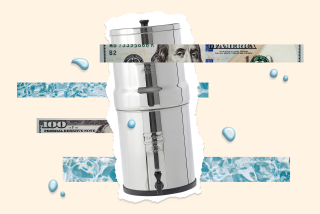On-Site Toxic Control Appears Poised to Clean Up With New System : Environment: Orders are starting to flow for the Santa Ana firm’s technology for decontaminating water with ultraviolet light.
- Share via
SANTA ANA — As many environmental entrepreneurs have discovered, developing a technology to clean up waste is easier than convincing people to use it. Government and private officials don’t like surprises and are often reluctant to try new, unproven techniques.
But persistence can eventually pay off.
Consider On-Site Toxic Control Inc. The Santa Ana-based company has developed a system to clean chemically contaminated water using ultraviolet light, and after six years in business, the orders are finally starting to flow.
David B. Fletcher, president of the 22-person firm, said that 16 of the systems have been sold so far, and five more sales are expected to close this month. If all goes according to plan, company revenues this year will double from the $1.6 million reported for the fiscal year ended June 30, Fletcher said, and making a profit is just around the corner.
The company’s technology, marketed through it’s Ultrox International subsidiary, uses a combination of high-intensity ultraviolet light, ozone and hydrogen peroxide to break down poisonous organic compounds that are dissolved in water. The chemicals, including many that are found in gasoline, pesticides and solvents, are reduced to a harmless combination of carbon dioxide, water and salt.
Most of Ultrox’s sales thus far have been to companies that use the system to clean dirty water from industrial processes.
But the system can also be used for ground water, and the California Department of Health Services recently chose the Ultrox technology to clean water from a contaminated well in South Gate. The $500,000 unit in South Gate will purify 1.5 million gallons of water a day in its 18-foot-long, 6-foot-high tank. Several established technologies for removing organic compounds from water already exist, but they rely on charcoal filters, which themselves become contaminated.
“Carbon gets the stuff out of the water, but then you have to do something with the carbon,” said Fletcher. “Our process gets rid of the problem, as opposed to concentrating it or transferring it.”
That can be especially important for certain kinds of applications, such as cleaning the cooling water in a nuclear reactor. Any waste generated from cleaning reactor water is radioactive, and thus very expensive to dispose of.
Robert Head, principal engineer in the nuclear power division of General Electric Co., said his company had been evaluating the Ultrox technology for five years, and was now prepared to market it to nuclear utilities.
“For this use, it’s the only kind of technology worth considering,” he said.
Ultrox also has an agreement with the Unipure Group of the Unocal Chemical Co. to sell a combined water treatment system to oil refineries. Unipure has a technology for removing heavy metals from the waste water, Fletcher explained, after the metals are eliminated the water flows to the Ultrox system to have the organic chemicals removed.
Ultimately, though, how many systems Ultrox sells will depend on how much dirty water actually gets cleaned up.
“It’s a huge market,” Fletcher said, “as long as people actually do it.”
More to Read
Inside the business of entertainment
The Wide Shot brings you news, analysis and insights on everything from streaming wars to production — and what it all means for the future.
You may occasionally receive promotional content from the Los Angeles Times.










